Korbinian Riedhammer
Pitfalls and Limits in Automatic Dementia Assessment
Aug 06, 2025Abstract:Current work on speech-based dementia assessment focuses on either feature extraction to predict assessment scales, or on the automation of existing test procedures. Most research uses public data unquestioningly and rarely performs a detailed error analysis, focusing primarily on numerical performance. We perform an in-depth analysis of an automated standardized dementia assessment, the Syndrom-Kurz-Test. We find that while there is a high overall correlation with human annotators, due to certain artifacts, we observe high correlations for the severely impaired individuals, which is less true for the healthy or mildly impaired ones. Speech production decreases with cognitive decline, leading to overoptimistic correlations when test scoring relies on word naming. Depending on the test design, fallback handling introduces further biases that favor certain groups. These pitfalls remain independent of group distributions in datasets and require differentiated analysis of target groups.
Personalized Fine-Tuning with Controllable Synthetic Speech from LLM-Generated Transcripts for Dysarthric Speech Recognition
May 19, 2025Abstract:In this work, we present our submission to the Speech Accessibility Project challenge for dysarthric speech recognition. We integrate parameter-efficient fine-tuning with latent audio representations to improve an encoder-decoder ASR system. Synthetic training data is generated by fine-tuning Parler-TTS to mimic dysarthric speech, using LLM-generated prompts for corpus-consistent target transcripts. Personalization with x-vectors consistently reduces word error rates (WERs) over non-personalized fine-tuning. AdaLoRA adapters outperform full fine-tuning and standard low-rank adaptation, achieving relative WER reductions of ~23% and ~22%, respectively. Further improvements (~5% WER reduction) come from incorporating wav2vec 2.0-based audio representations. Training with synthetic dysarthric speech yields up to ~7% relative WER improvement over personalized fine-tuning alone.
Adapter-Based Multi-Agent AVSR Extension for Pre-Trained ASR Models
Feb 03, 2025Abstract:We present an approach to Audio-Visual Speech Recognition that builds on a pre-trained Whisper model. To infuse visual information into this audio-only model, we extend it with an AV fusion module and LoRa adapters, one of the most up-to-date adapter approaches. One advantage of adapter-based approaches, is that only a relatively small number of parameters are trained, while the basic model remains unchanged. Common AVSR approaches train single models to handle several noise categories and noise levels simultaneously. Taking advantage of the lightweight nature of adapter approaches, we train noise-scenario-specific adapter-sets, each covering individual noise-categories or a specific noise-level range. The most suitable adapter-set is selected by previously classifying the noise-scenario. This enables our models to achieve an optimum coverage across different noise-categories and noise-levels, while training only a minimum number of parameters. Compared to a full fine-tuning approach with SOTA performance our models achieve almost comparable results over the majority of the tested noise-categories and noise-levels, with up to 88.5% less trainable parameters. Our approach can be extended by further noise-specific adapter-sets to cover additional noise scenarios. It is also possible to utilize the underlying powerful ASR model when no visual information is available, as it remains unchanged.
Infusing Acoustic Pause Context into Text-Based Dementia Assessment
Aug 27, 2024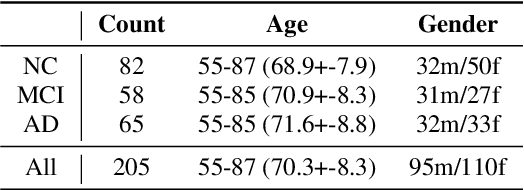
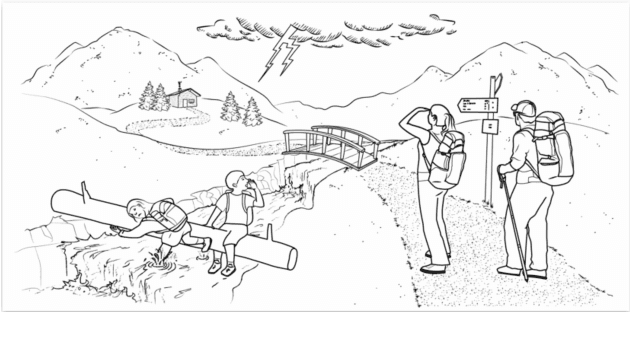
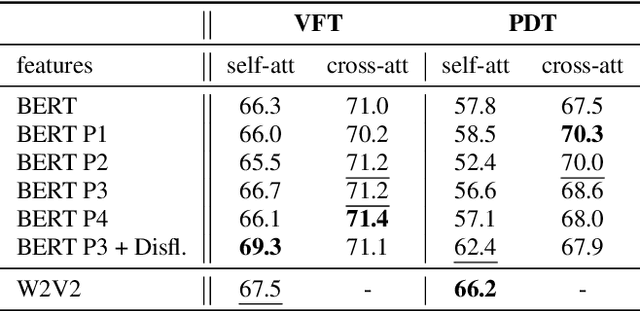
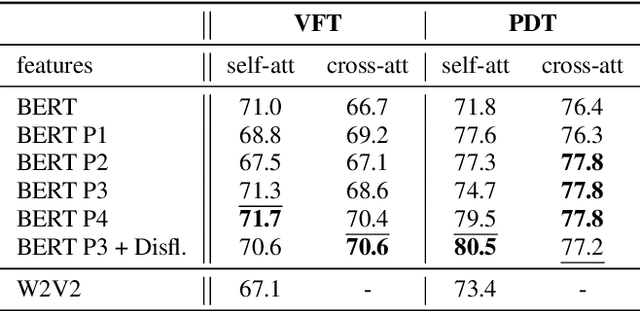
Abstract:Speech pauses, alongside content and structure, offer a valuable and non-invasive biomarker for detecting dementia. This work investigates the use of pause-enriched transcripts in transformer-based language models to differentiate the cognitive states of subjects with no cognitive impairment, mild cognitive impairment, and Alzheimer's dementia based on their speech from a clinical assessment. We address three binary classification tasks: Onset, monitoring, and dementia exclusion. The performance is evaluated through experiments on a German Verbal Fluency Test and a Picture Description Test, comparing the model's effectiveness across different speech production contexts. Starting from a textual baseline, we investigate the effect of incorporation of pause information and acoustic context. We show the test should be chosen depending on the task, and similarly, lexical pause information and acoustic cross-attention contribute differently.
MMUTF: Multimodal Multimedia Event Argument Extraction with Unified Template Filling
Jun 18, 2024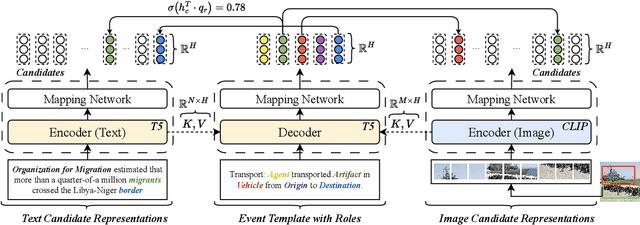

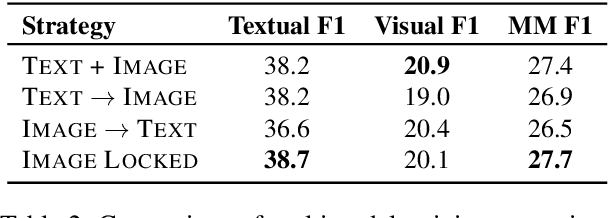
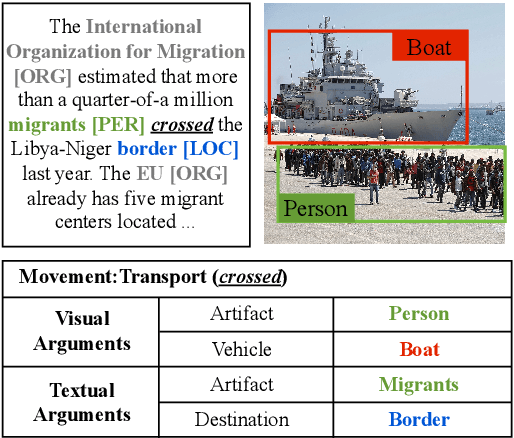
Abstract:With the advancement of multimedia technologies, news documents and user-generated content are often represented as multiple modalities, making Multimedia Event Extraction (MEE) an increasingly important challenge. However, recent MEE methods employ weak alignment strategies and data augmentation with simple classification models, which ignore the capabilities of natural language-formulated event templates for the challenging Event Argument Extraction (EAE) task. In this work, we focus on EAE and address this issue by introducing a unified template filling model that connects the textual and visual modalities via textual prompts. This approach enables the exploitation of cross-ontology transfer and the incorporation of event-specific semantics. Experiments on the M2E2 benchmark demonstrate the effectiveness of our approach. Our system surpasses the current SOTA on textual EAE by +7% F1, and performs generally better than the second-best systems for multimedia EAE.
Optimized Speculative Sampling for GPU Hardware Accelerators
Jun 16, 2024
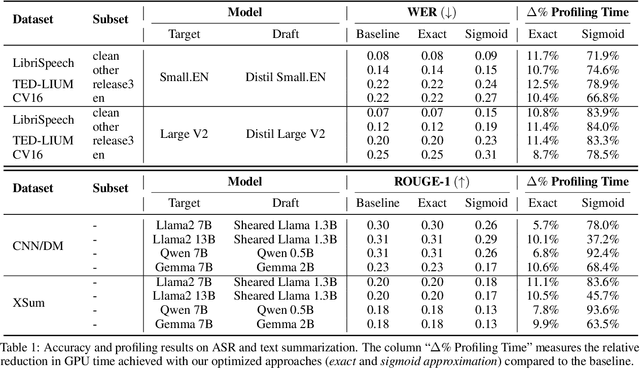


Abstract:In this work, we optimize speculative sampling for parallel hardware accelerators to improve sampling speed. We notice that substantial portions of the intermediate matrices necessary for speculative sampling can be computed concurrently. This allows us to distribute the workload across multiple GPU threads, enabling simultaneous operations on matrix segments within thread blocks. Additionally, we use fast on-chip memory to store intermediate results, thereby minimizing the frequency of slow read and write operations across different types of memory. This results in profiling time improvements ranging from 6% to 13% relative to the baseline implementation, without compromising accuracy. To further accelerate speculative sampling, probability distributions parameterized by softmax are approximated by sigmoid. This approximation approach results in significantly greater relative improvements in profiling time, ranging from 37% to 94%, with a slight decline in accuracy. We conduct extensive experiments on both automatic speech recognition and summarization tasks to validate the effectiveness of our optimization methods.
Large Language Models for Dysfluency Detection in Stuttered Speech
Jun 16, 2024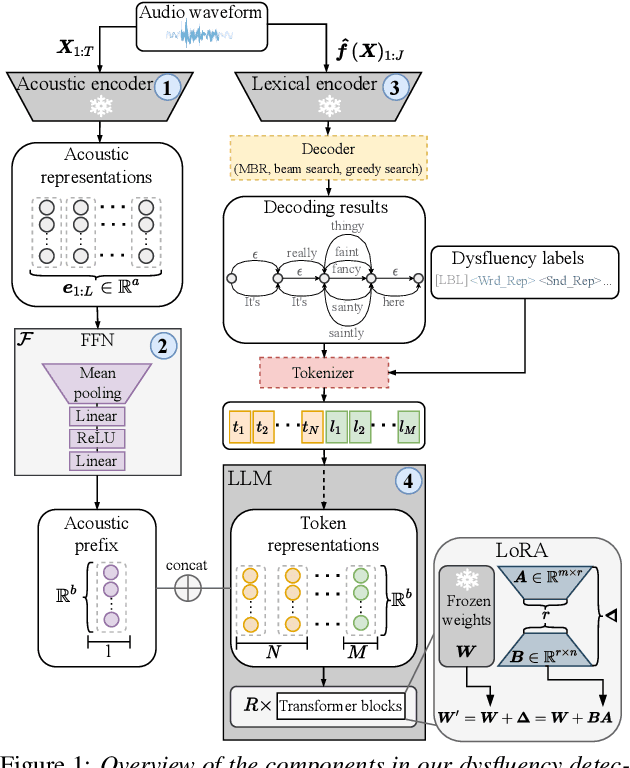
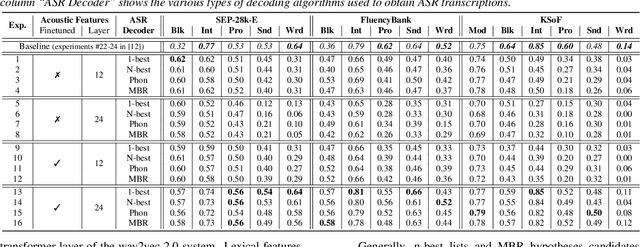
Abstract:Accurately detecting dysfluencies in spoken language can help to improve the performance of automatic speech and language processing components and support the development of more inclusive speech and language technologies. Inspired by the recent trend towards the deployment of large language models (LLMs) as universal learners and processors of non-lexical inputs, such as audio and video, we approach the task of multi-label dysfluency detection as a language modeling problem. We present hypotheses candidates generated with an automatic speech recognition system and acoustic representations extracted from an audio encoder model to an LLM, and finetune the system to predict dysfluency labels on three datasets containing English and German stuttered speech. The experimental results show that our system effectively combines acoustic and lexical information and achieves competitive results on the multi-label stuttering detection task.
Outlier Reduction with Gated Attention for Improved Post-training Quantization in Large Sequence-to-sequence Speech Foundation Models
Jun 16, 2024Abstract:This paper explores the improvement of post-training quantization (PTQ) after knowledge distillation in the Whisper speech foundation model family. We address the challenge of outliers in weights and activation tensors, known to impede quantization quality in transformer-based language and vision models. Extending this observation to Whisper, we demonstrate that these outliers are also present when transformer-based models are trained to perform automatic speech recognition, necessitating mitigation strategies for PTQ. We show that outliers can be reduced by a recently proposed gating mechanism in the attention blocks of the student model, enabling effective 8-bit quantization, and lower word error rates compared to student models without the gating mechanism in place.
A Survey of Music Generation in the Context of Interaction
Feb 23, 2024



Abstract:In recent years, machine learning, and in particular generative adversarial neural networks (GANs) and attention-based neural networks (transformers), have been successfully used to compose and generate music, both melodies and polyphonic pieces. Current research focuses foremost on style replication (eg. generating a Bach-style chorale) or style transfer (eg. classical to jazz) based on large amounts of recorded or transcribed music, which in turn also allows for fairly straight-forward "performance" evaluation. However, most of these models are not suitable for human-machine co-creation through live interaction, neither is clear, how such models and resulting creations would be evaluated. This article presents a thorough review of music representation, feature analysis, heuristic algorithms, statistical and parametric modelling, and human and automatic evaluation measures, along with a discussion of which approaches and models seem most suitable for live interaction.
Multi-Query Focused Disaster Summarization via Instruction-Based Prompting
Feb 14, 2024Abstract:Automatic summarization of mass-emergency events plays a critical role in disaster management. The second edition of CrisisFACTS aims to advance disaster summarization based on multi-stream fact-finding with a focus on web sources such as Twitter, Reddit, Facebook, and Webnews. Here, participants are asked to develop systems that can extract key facts from several disaster-related events, which ultimately serve as a summary. This paper describes our method to tackle this challenging task. We follow previous work and propose to use a combination of retrieval, reranking, and an embarrassingly simple instruction-following summarization. The two-stage retrieval pipeline relies on BM25 and MonoT5, while the summarizer module is based on the open-source Large Language Model (LLM) LLaMA-13b. For summarization, we explore a Question Answering (QA)-motivated prompting approach and find the evidence useful for extracting query-relevant facts. The automatic metrics and human evaluation show strong results but also highlight the gap between open-source and proprietary systems.
 Add to Chrome
Add to Chrome Add to Firefox
Add to Firefox Add to Edge
Add to Edge